The research, conducted by collaborators from Earlham College and Indiana University, focused on a group of landowners who elected to participate in conservation easements (CEs) for portions of their property. CEs are legally binding agreements that maximize the conservation value of land by limiting particular activities, such as development and industrialization. Despite the importance of this conservation tool throughout the US, little is known about what--other than potential tax breaks--inspires people to participate in CEs. Thus, the current research was conducted in order to explore the conservation mindsets of CE landowners and to determine how their attitudes towards environmentalism were formed.
(Border of a conservation easement in Virginia, USA)
To do this, the researchers used a two-phase survey process to collect both quantitative and qualitative data. During the first phase, they conducted phone interviews with CE adopters in order to identify common themes associated with people who engaged in this particular conservation behavior. Within 16 interviews, the researchers noted a "saturation" of concepts, terms, and phrases; in other words, the interviewees had seemingly exhausted the list of potential reasons why someone might be interested in becoming involved in a conservation easement. Four main types of inspiration consistently emerged as "significant life experiences" (SLEs) that fostered an interest in land preservation: the impact of family and friends, unstructured time spent outdoors (during both play and exploration), exposure to the outdoors while on a farm, and structured activities led by non-relative adults.
Using these findings, the scientists developed a detailed, 8-page questionnaire exploring these themes in greater detail. Specifically, the questionnaire asked about the extent to which different activities influenced individuals' conservation ideals; there was also a final open-ended question asking participants to describe what single experience, if any, most influenced their feelings towards land conservation, and why. During the second phase of the survey, the questionnaire was distributed to 84 landowners, 64 of whom responded.
(Children climbing trees--one of many "unstructured outdoor activities" that can have impacts on the conservation mindsets that they will have as adults)
"Individual experiences in nature" was listed as the most important factor, followed by "free play outdoors," "planned outdoor experience" and "parents/guardians." There was a significant difference between the top two influences (individual experience and free play), as well as between the second and third (free play and planned experience). Other options (including, but not limited to, news media, summer camp, historic event, teachers, and 4-H) generally had similar impacts, though friends (6th most important on the list) were found to be significantly more important than news media (7th most important on the list). Answers to the open-ended question aligned with those given elsewhere during both phases of the experiment: Respondents cited things like individual experiences, farm experiences (free play, in particular), growing up in and around nature, and family members and activities.
Overwhelmingly, the results of the study indicate that early life activities are a vital element in the development of pro-environmental behaviors later in life. While similar patterns have previously been found in studies of environmental activists, this is the first study to show that "ordinary" citizens--who do not necessarily make conservation their life's work--are similarly impacted by the events of their childhoods. Particularly interesting was the finding that unstructured and informal childhood experiences are significantly different--and, seemingly, more important--than other types of outdoor activities. This is a pattern that has consistently been found regardless of nationality and geographical location.
These results emphasize the importance of having natural areas available for recreational activities. Given the extent of urbanization and the speed at which it is increasing, the authors express some worry that there could be a cycle of negative feedback reducing conservation activity in the future: Since the majority of the human population now lives in urban areas, many of today's children may not experience much nature during their formative years, causing a reduction in land preservation activity over the next couple decades, leading to even further decreases in natural experiences, and so on. Clearly, it is important to encourage parents to take their children to wilderness areas.
(A structured environmental education program. Though seemingly not as important as free time outside, activities like this do appear to play a role in fostering a conservation mindset.)
One question raised by the current study is how important formalized environmental programs really are. Although they were consistently listed within the top 4 activities influencing conservation attitudes, they always ranked beneath unstructured events such as play and exploration. It will be important to understand the impact of outreach activities and determine whether there are ways to improve their efficacy. Other follow-up research might seek to compare CE landowners and non-CE landowners in order to investigate whether, and which, early life experiences differ between the two groups. In addition to helping parents and educators foster stronger and better relationships between children and nature, an increased understanding of how the conservation mindset is developed will enable managers to better target those individuals who are likely to be most interested in assisting with environmental efforts. This could be particularly important in urban areas, where wilderness habitats, and the opportunities to utilize them, may be few and far between.
---
Farmer, J.R., Chancellor, C., Fischer, B.C. 2011. Space to romp and roam and how it may promote land conservation. Natural Areas Journal 31(4):340-348.
Thanks to the following websites for providing the images used in this post:
http://activerain.com/blogsview/488329/virginia-outdoor-foundation-conservation-easement
http://www.npt.gov.uk/default.aspx?page=2349
http://www.mckeever.org/


No comments:
Post a Comment